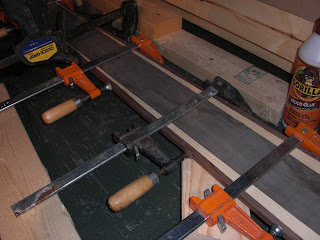My fire hose arrived. They sent me 12' instead of the 10' I ordered so I decided to make a baby size test piece. I used 1" angle iron bolted together with 5/16" Grade 8 bolts to seal the ends. For the valve I used a tire stem very similar to
This one. I got it from a local tire store who graciously gave to me for free. (Thanks Mr. Hill) I also got some larger steel and rubber washers from the hardware store.
I installed the whole thing into my hose as shown:
Large steel washer and large rubber washer underneath hose. The same reversed above the hose. Above that the rubber washer that came on the tire stem and the steel washer that came with it. On the top the nut. Teflon tape on the threads of the stem.
The little hose held pressure decently, so I decided to move it up to the larger scale. Unfortunately, when I inflated the big piece of the hose I discovered a hole almost exactly in the middle of it. I called Heartland Pump (where I purchased the hose) and they were very helpful. They sent out a new piece of hose that day (free) and I received it 2 days later. This new piece hasn't leaked in the body at all. It seems that air leaks out of the threads of the bolts clamping the ends of the hose. I think some Teflon tape will solve this. Other than that the hose is a success.

I have also completed the router bridge I will use to profile my cores. I think my design is pretty original. I combined several ideas I had seen on the skibuilders.com forums for adjustable planer cribs and adjustable router bridges and adjustable molds. It has a plywood base with flat rails running the length of it. The router rests in a crib that runs on these rails. The router can move across the width of the crib, and the crib slides lengthwise along the rails.
Two pieces of MDF are screwed onto the plywood base. They are only attached in the middle, however.
At then ends I have
T-Nuts hammered into the plywood base. These have bolts that screw into them with a Phillips head.
I drilled holes in the MDF to allow me to adjust them with a screwdriver without taking the MDF off. By screwing them up I bend the MDF up at the ends. The core then goes onto the MDF and is bent to match the curve of the MDF. It will be held down with doublesided tape or screws on the waste portion of the wood.
This allows me to shape the core to be thinner at the ends and thicker at the middle.
And finally here's a picture of the almost complete press.
From top to bottom:
Top Beam
Top Mold
Fire hose
Cat Track
1/8" Masonite
Ski
1/4" Masonite
Bottom Mold
Bottom Beam
My latest purchases:
10' of 6" discharge hose: $45
4' of 1" angle iron: $8
10 5/16" Grade 8 Bolts and Nuts: $11
Rubber and Steel Washers: $1
Total thus far: $157
Final expected purchases:
Cordura wraps: ~$40?
Hopefully that's it, which would leave me at just under $200.
Cost of 1 pair of skis:
Everything but core and epoxy (skibuilders.com): ~$90+shipping
Core: Free (have wood already)
Epoxy: ~$20/ski? (not sure here)
Total: ~$130
















